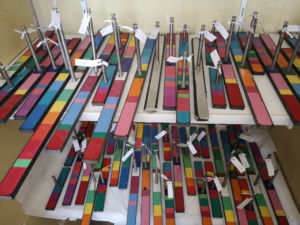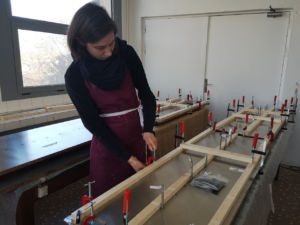Yaacov Agam's work soon to be restored
For several weeks now, Yaacov Agam's work "8+1 en mouvement" has been undergoing restoration at the University of Montpellier. Acquired in 1969 by the University of Sciences of Montpellier, it adorned the hall of its administrative building for almost 36 years before being removed in 2005. An important piece of the UM's artistic heritage, it will soon be available to the public once again.
"This is a complex restoration project, which will take us between one and two months to complete," says Rémy Geindreau, curator-restorer specializing in technical, scientific and industrial heritage. Together with his colleague Mélanie Paul-Hazard, who specializes in sculpture and contemporary art, they are working patiently in the historic premises of the Faculty of Medicine to care for a work that has been badly damaged by time.
"8+1 in motion". Created in 1969 by Yaacov Agam. At the time, architects Philippe Jaulmes and Jean de Richemond were in charge of building the new campuses of the faculties of science and literature. As part of the "1% artistic" scheme introduced in 1951, which required the State to commission works of art to decorate public buildings, the two architects designed an ambitious decoration program, calling on renowned artists such as Pol Bury, Yvaral and Yaacov Agam.
Designed to play with light
A specialist in kinetic art, Yaacov Agam delivers a work designed to play with the effects of light and form. "It's made up of 18 wooden panels covered with stainless steel plates set against a black-painted wall. The installation is 16 metres long in all. You might think that the panels are all identical, but they all have minute variations," explains Rémy Geindreau.
On each panel are eight small black fins fitted with a mechanism that allows them to be rotated, inviting the public to modify the compositions. On the reverse of each fin, a spectrum of colors is reflected in the panel's polished metal, creating different lighting effects depending on the position given to the fins.
A work that has become unreadable
Over time, alas, "56 fins (out of 144) have disappeared or been broken, and the stainless steel plates have become soiled that they no longer reflect the color spectra. The whole kinetic dimension has been lost, and the work has become illegible to the public", says Audrey Théron, in charge of museum collections at the University of Montpellier. To prevent further damage, the work was taken down in 2005 and stored in various locations before arriving at the historic site of the Faculty of Medicine.
So we had to wait 15 years for this "8+1″ to finally get moving again. A long time, but a necessary one for Audrey Théron, "the 1% artistic obligation requires public establishments to maintain the works, which can sometimes be costly. We have to find the funding." The cost of the first stage of restoration is €20,000, paid for by the Direction régionale des affaires culturelles (DRAC).
Stop alterations
"The aim of this restoration is not to make the work as good as new, but to halt the evolutionary alterations in order to protect it and restore its legibility," explains Mélanie Paul-Hazard. Even if they are deformed or scratched, there is no question of replacing the stainless steel plates or polishing them excessively. The aim is to preserve the physical integrity of the work, to retain the original material. This involves compromises, such as leaving deep scratches."
Each stainless steel panel was completely dismantled, dusted, cleaned, glued and polished. Deformations in the steel were partially corrected, and the edge banding reconstituted where it had disappeared. The fin-locking mechanisms were dismantled, declutched if necessary and treated against corrosion. Remaining fins were straightened, cleaned and any impact mitigated.
Real investigative work
As Rémy Geindreau points out: "We have fewer studies available for restoring stainless steel than for ancient archaeological metals". This difficulty is all the greater when the restoration involves the reconstitution of missing elements, in particular the fins and their color spectrum. "Color sequencing on fins is not random, and we've already identified eight patterns that come back. Restoration requires real investigative work to understand how the work was conceived".
Another requirement for restorers is reversibility, as Mélanie Paul-Hazard explains. "Everything we add to the work must be removable. We don't use epoxy glue, for example, but a reversible glue with good aging properties." All the work carried out by the restorers is precisely documented in a report. "It's important to differentiate between what is original and what has been modified by successive restorers, so as not to misunderstand the work decades from now."
An artistic heritage to rediscover
In a few months' time, "8+1 en mouvement" should be back in its original position on the Triolet campus, offering a new generation of students the chance to enjoy its play of colors. This will be an opportunity to rediscover the University's artistic heritage, including Pol Bury's Colonnes (1974), Yvaral's frescoes and cladding for the university library (1972), François Desnoyer 's tapestry (1972), and Albert Dupin's Sept signes de vie (1970). Not forgetting, of course, the new works that will enhance the brand-new Village des Sciences.

